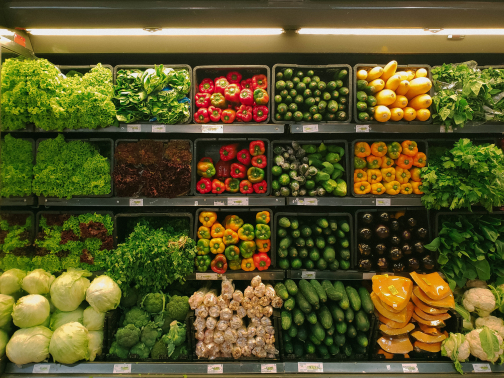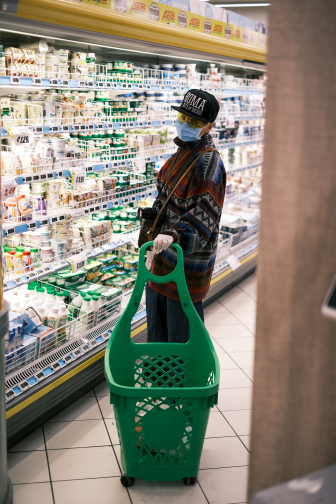Safe Grocery Shopping Tips During COVID-19
Our life has changed in recent months due to mandatory shelter-in-place guidelines and the urgency to practice social distancing in public. For some, this changes the way we work, exercise and of course, the way we eat. Right now, proper nutrition is important, perhaps more now than ever. Here are some tips on how to maintain a healthy diet. Before you go grocery shopping, learn our tips on how to navigate it safely.
General Grocery Shopping Tips 
Create a Menu. One of the best ways to grocery shop is to decide what you want to eat for that week or like to eat on a regular basis. Keep in mind that these foods should benefit your blood glucose goals and what you truly enjoy. Include these foods on your shopping list.
Make a Grocery Shopping List. Before you venture out to the store, make a list ahead of time. Do some shopping within your own pantries and refrigerator. Make sure your list contains the essentials such as spices and herbs, sides, fruits, vegetables and food items that can serve as a main dish. In addition to helping you prevent food waste and save you money, having a list can help you shop quickly and minimize your risks for contracting COVID-19. Also, this can prevent food waste in your own home and save you money. For more ideas on what you should buy, check out our clean eating grocery list.
Buy Only What You Need and Will Use. The U.S. Food and Drug Administration recommends buying at least one-to-two weeks of groceries. Buying more could cause temporary shortages in the food supply chain. When it comes to purchasing fresh produce if you buy more than what you’ll use within a few days, chop them up and place them in a freezer to prevent waste.
Start on the outside aisles of the store. The outer aisles of the supermarket usually have the healthiest items such as fruits, vegetables, fresh herbs, freshly baked bread and dairy products. Start there and work your way in.
Read the Food Label. Before placing some items in your cart, especially those with claims that promote health such as “improves cholesterol” or make claims such as being “sugar-free,” look for other indicators that could be problematic. For example, a “fat-free” item could be higher in carbohydrate than it’s regular counterpart. For more information on how to read a food label, click here.
Buy Frozen Foods. Buying frozen foods is a great way to save money while purchasing healthy foods, as well as save time in the kitchen. Frozen fruits and vegetables are picked at their peak ripeness and frozen. Worried they may not be as nutritious as fresh ones? Don’t be. They still retain their nutritional content. However, some frozen items such as meats and pre-made meals may be higher in saturated fat and sodium. Before buying, take a look at the food label and choose frozen foods that align with your goals.
Buy Canned Foods and Other Non-Perishables. Canning preserves nutrients, so canned goods can be just as nutritious as fresh and frozen foods. Steer clear of canned foods soaked in syrup and oil and focus on canned items in water, are low in sodium, or have no sodium added. Before cooking with canned foods such as beans and vegetables, rinse and drain them. Also, purchase other non-perishables such as rice, barley, nuts, seeds, oats and whole-wheat pasta. If you’re gluten-free or on a low-carb diet, you can find alternative pasta such as lentil, chickpea, black bean, hearts of palm, or almond flour pasta. You can also buy frozen zoodles—zucchini noodles, as an alternative to traditional pasta.
Stay Safe at the Grocery Store during COVID-19
Wear a mask. Follow the recommendations issued by your local health authorities. Remember that masks, in addition to protecting others, will help us adhere to the other CDC guideline on not touching our faces.
Carry sanitizing wipes with you. When taking your grocery cart make sure you clean it well before you grab it. Take antibacterial gel with you to clean your hands frequently, as well as the cart surfaces where you’ll be placing your food items.
Don’t Touch What You Won’t Buy. To prevent the spread of coronavirus, please don’t touch what you’re not going to buy. If you must touch food items, please disinfect your hands using hand sanitizer or disinfectant wipes.
Practice social distancing. Health officials encourage remaining 6 feet apart at all times. However, this may be difficult to do in a public setting such as the grocery store. Still, aim to maintain your distance from others and follow any social distancing rules set by the store. Some stores have segmented checkout lines for customers to adhere to social distancing rules. Also, some stores may only allow a certain number of people at once to shop. Finally, some stores have set special hours for seniors and high-risk individuals to shop for groceries and minimize their risk of contracting the virus. Please check with your local store for more information.
Remember These Golden Rules. Do not touch your face and cover your mouth and nose with your elbow if you sneeze or cough. Try not to handle your cell phone, which is another service that could contain coronavirus. If you need to use your phone, use a disinfectant wipe.
Should You Disinfect Your Groceries?
According to experts, you don’t have to sanitize your groceries because the rate of transmission from them to you is low. Angela Rasmussen, a virologist at the Center for Infection and Immunity at Columbia University’s Mailman School of Public Health, told NPR that respiratory droplets would need to land in a specific area, you would need to touch that area and then touch your face with enough residual virus to get coronavirus. She recommends continuing to practice good hand washing techniques and washing them after unpacking your groceries. However, if you want to sanitize your groceries, other experts in the article do not recommend using household disinfectants meant to be used on hard surfaces. Instead, just use soap and water.





